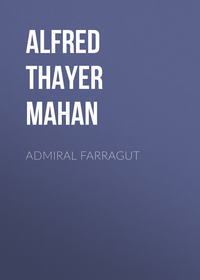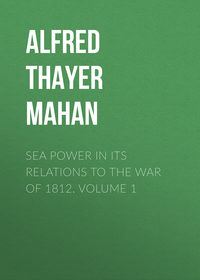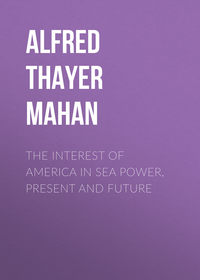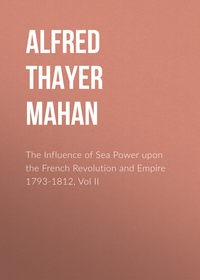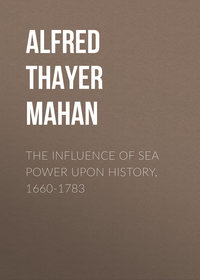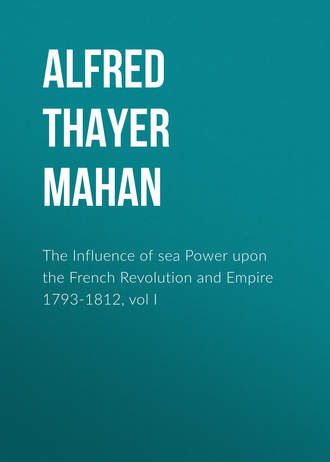 полная версия
полная версияThe Influence of sea Power upon the French Revolution and Empire 1793-1812, vol I
Great Britain had now resumed tranquil possession of all the eastern islands, except Guadaloupe. The strong organization which this had received from Hugues, and the re-enforcements that had been thrown in, indicated that prolonged operations would be needed to effect its subdual. The sickly rainy season was at hand, during which also hurricanes prevail, so that all reasons combined to postpone the attempt to the healthier months,—a decision which was amply justified by the great mortality from yellow fever which ensued among the troops, despite all the immunity from exposure that care and the cessation of campaigning could give. By the time that operations could begin, Spain had declared war against Great Britain; and the prospect of easily seizing her large and far more valuable islands diverted attention from Guadaloupe. The latter continued throughout this and the following war, until 1810, a thorn in the side of British trade. The recapture of Guadaloupe by the French, and the consequent evils, remain a pregnant warning against the folly of sending a boy to do a man's work; but underlying that miscalculation appears to have been the fatal error of relying upon local support to troops inadequate by themselves to the task before them. Desirous of doing many things at once, the British government easily accepted the assurances of a few royalists, as to the political dispositions of a most excitable and changeable race and the re-enforcements that could be raised among them. It was an exact repetition of the blunder which led to the invasion of the Southern colonies during the American Revolution; and the gist of the mistake is in the dependence upon unorganized forces to supplement the weakness of the organized force, which is not by itself alone sufficient to its undertaking.
It will not be denied that at times a diversion under such conditions may be attempted, if it does not take away force needed for serious enterprises. Upon this ground may perhaps be justified the attempted French invasion of Ireland in December, 1796, which, though on a somewhat larger scale, essentially resembled the expedition of Jervis and Grey against the West Indies. It also depended upon a local rising in favor of an insufficient force, upon the support of practically unorganized masses without military antecedents; but it was undertaken at a period when the tide of affairs elsewhere was running strongly in favor of France, and, whatever hopes may have been entertained of possible ultimate results, was essentially a diversion. The immediate aim was not a direct gain to France, but an indirect advantage, by accumulating embarrassments for Great Britain. A state entirely inferior at sea could not count upon lasting military control of a large island with an alien population; but it could hope that the insurrection of Ireland, concurring with disaster upon the Continent, might force a disadvantageous peace upon the arch enemy. The conquest of the smaller Antilles, on the contrary, was not properly a diversion, but an object of real importance to a great British interest. It was feasible for the greater naval power to take and hold them, being small; and their tenure, by relieving the navy of part of its work, would have facilitated the protection of Jamaica and its trade, as well as the general control of the western Caribbean. Haïti was too large and too populated for conquest; but its power for injury could have been confronted with more substantial force had Guadaloupe remained a British garrison.
The alliance of Spain and Holland with France much increased the difficulties of Great Britain, by throwing open their colonial ports to French privateers. The extensive sea-coasts of Cuba and Haïti became alive with them. In 1807 it was estimated that there were from two to three hundred depending upon these two islands, and unfitted, from their size, to go far from them. 77 The number testifies to the extent and value of British trade in that sea, although the privateer did not confine his depredations to the enemy, but preyed lawlessly on neutrals as well. The same authority illustrates the annihilation of French and Spanish commerce by stating that not more than two or three British privateers were sailing from Jamaica.
General Abercromby went for a short time to Europe in the fall of 1796. Upon his return a strong military and naval expedition was sent against Trinidad, but did not meet the resistance expected from the size and importance of the island. It capitulated on the second day, February 18, 1797, and with it the Spaniards lost four ships-of-the-line. Thence Abercromby moved, in April, against Porto Rico; but upon reconnoitring, the defences were found too strong, and the troops were re-embarked after losing two hundred men. This ended the colonial expeditions in the West Indies for the first war. Quiet possession was taken of the Dutch colonies of Surinam and Curaçoa in 1799 and 1800; and in 1801, when Sweden and Denmark became involved in hostilities with Great Britain, their West India islands were also given up without resistance, but no further fighting took place.
Note. As it does not enter into the author's plan to give in detail the naval history after Trafalgar, it may be well to state here, in brief, the subsequent events in the West Indies. At the Peace of Amiens in 1801, Great Britain restored all her West India conquests except the Spanish Trinidad. When war broke out again in 1803, Tobago, Santa Lucia, Demerara, Essequibo, and Berbice were at once seized without difficulty, as was Surinam in 1804. There matters rested till 1807, when Curaçoa and the Danish islands fell, followed in 1809 by Martinique, and in 1810 by Guadaloupe. Spain having become again the ally of Great Britain in 1808, the latter had now no open enemy in the Caribbean; but the long habits of lawlessness left numerous pirates infesting Cuba, whom the weak Spanish government failed to control.
CHAPTER V
The Naval Campaign of May, 1794, and Battle of the First of JuneTHE pressure of the allied armies upon all her frontiers, combined with the British mastery of the sea, had thrown France largely upon her own resources during the year 1793; while the distracted condition of the country and a bad harvest had united to cause a scarcity of bread-stuffs, which threatened a famine, with all its consequences of sufferings to the army and the people, and inevitable increase of disturbance and sedition.
The eyes of the government had therefore turned beyond the sea to the United States, and its representatives there had been directed to accumulate a quantity of provisions to be shipped to France. It was intended to despatch these in a great convoy, to be protected on the voyage by a force of ships-of-war; while its approach to the shores of Europe would be covered by a sortie of the great fleet from Brest and Rochefort, to occupy the attention of, and, if necessary, forcibly to contest the control of the sea with, the British navy. Experience had not yet corrected the sanguine confidence of the republican government, based upon the wordy enthusiasm of the crews, nor taught it that, with the departure of the trained officers and the spread of license among the men, the navy had ceased to be the strong power which had faced Great Britain with success in the war of the American Revolution. The very measures which had most contributed to destroy its efficiency became, in the excitement and ignorance of the times, the sure gage of victory.
The convoying squadron of two ships-of-the-line and three smaller vessels sailed from Brest for the United States in December, 1793, under the command of Rear-Admiral Van Stabel, an active and judicious officer. On the 12th of February it anchored in Chesapeake Bay, and sailed again for France on the 11th of April. The merchant ships under its charge numbered one hundred and thirty, 78 among them being many laden with produce from the French West India islands, which, not venturing to make the passage home direct and unattended, for fear of British cruisers, had collected at Hampton Roads to await the time of sailing. It seems somewhat remarkable that the British government, which was fairly well informed as to the designs of the French, should not have attempted to intercept the convoy at its port of departure. That is the point at which a great maritime expedition, whether purely military or otherwise, can usually be most effectually watched; and in this case the more so, because, if the convoy had eluded the blockading squadron, the latter, few in number and homogeneous, could easily have outstripped the unwieldy multitude and again awaited it off its port of arrival. The success of this mass of merchantmen in escaping the numerous enemies that attended it off the coast of France is a striking illustration of the uncertainties of commerce-destroying, and of the chances that favor the safe arrival of a body of ships when the enemy is in doubt as to their exact destination.
The French minister to the United States, M. Genêt, had written home that he would forward a part of the convoy, under the care of two small ships of war, as soon as possible. With the idea that these might have sailed before Van Stabel reached America, a force of five ships-of-the-line with some lighter vessels was directed to protect their arrival. This squadron accordingly sailed from Brest under the command of Rear-Admiral Nielly, on the 10th of April. 79 It had been preceded by a light division, whose mission was to meet the convoy and inform the officer in charge that Nielly would await him a hundred leagues west of Belle-Isle.
Later news corrected the expectations based upon Genêt's first despatches, and as the close approach of summer made it more easy for the British fleet to maintain its position in the Bay of Biscay, and consequently increased the dangers through which the convoy must pass, the French government determined to send out all the available ships in Brest. On the 16th of May the great fleet, comprising twenty-five ships-of-the-line, one of which carried one hundred and twenty guns and three others one hundred and ten, sailed under the command of Rear-Admiral Villaret Joyeuse. A representative of the National Convention, charged with duties resembling those of the representatives present with the armies in the field, embarked on board the flag-ship, "La Montagne." This magnificent vessel, called under the monarchy the "États de Bourgogne," now bore the name of the terrible party dominant in the National Convention. These were still the days of the Terror, and Robespierre had yet two months to live when the fleet sailed from Brest. The admiral's orders were to cruise in the same station that had already been assigned to Nielly, with whom he was expected to form a junction, and to protect the approach of the convoy at all hazards, but not to fight unless essential to secure that end, to which all other objects were subordinated. The time of waiting was to be utilized for fleet manœuvres, in which the representative and admiral had too much reason to fear that the captains were unskilled.
The anxiety of the French government about the convoy, and the embarrassment which would be caused by its loss, were obvious incentives to the British authorities to do all in their power to intercept it. The Channel fleet, so called from the ports upon which its operations were based, had returned from its cruises of the previous year in December, and had since then remained at anchor, repairing and refitting for the next year's work. Its commander, Lord Howe, as has before been said, 80 was averse from keeping the sea in winter with the heavy ships. According to his system of warfare, the fleet should be anchored at some convenient point on the Channel coast, and depend upon frigates stationed before the French ports to bring it word of the enemy's movements. Had, however, the expected convoy in 1794 sailed from America as soon as it was expected to do, it would have reached its own ports before the British had left their anchors.
On the 2d of May the Channel fleet, numbering thirty-four ships-of-the-line and attended by fifteen frigates and smaller ships-of-war, sailed from Spithead. It had under its charge one hundred and forty-eight sail of merchantmen, bound to Newfoundland and to the East and West Indies. Upon arriving two days later off the Lizard, a promontory near the south-west extremity of England and a hundred miles due north of the Island of Ushant, Howe detached eight ships-of-the-line to accompany the convoy to the latitude of Cape Finisterre, on the north-west coast of Spain. After performing this service, six, under Admiral Montagu, were to cruise between Cape Ortegal and the latitude of Belle-Isle, to intercept the convoy from America. The width, over two hundred miles, of the belt of ocean to be covered by these six ships with their accompanying frigates, taken in connection with the chances which night and fog might give the French convoy for passing unobserved, illustrates the comparative disadvantages of lying in wait at the supposed point of arrival, instead of at the known port of departure, for a body of vessels whose precise destination is in doubt.
Howe, with the twenty-six ships remaining to him, steered directly for Ushant, reconnoitred Brest, and, having ascertained that the bulk of the French fleet was still in port, proceeded to cruise in the Bay of Biscay, moving backward and forward across the probable track of the expected convoy. On the 19th of May he again looked into Brest, and found that the French had sailed. The same evening a frigate from Montagu joined him, requesting a re-enforcement, as the rear-admiral had learned from a captured vessel that Nielly's squadron was at sea, and that Van Stabel's force numbered four of the line. He consequently anticipated the possibility of falling in with nine ships-of-the-line, which would be too large a number for his own six to meet. As the frigate, of course, brought word where Montagu was to be found, Howe, knowing that the main French fleet was out, steered at once to join his subordinate; but ascertaining later, from passing vessels, that Villaret had been seen in a position and heading a course which would take him well clear of Montagu, he abandoned this purpose and went directly in pursuit of the enemy. The latter, by the information he received, numbered twenty-six ships-of-the-line, precisely equalling his own fleet.
A week, however, was to elapse before he found the French. On the morning of the 28th of May, the wind being then south by west, the lookout frigates signalled a strange fleet to windward. It proved to be that of Villaret, then steering north-north-east, nearly before the wind, in three columns. At the time of this meeting, Howe was running back to the eastward with a fair wind, having actually gone a hundred miles west of the enemy's rendezvous without finding him. The French admiral stood on until he could recognize the British, and then hauled to the wind, intending to form his line-of-battle on the port tack, heading west or a little south of it. The inexperience of the captains, of whom a large proportion had no naval training and had never commanded ships in a fleet, led to a long delay and a poor formation. Lord Howe, on the contrary, soon had his fleet in manageable condition, pressing to windward in two columns on the port tack, and with a flying squadron of four fast and handy seventy-four-gun ships well to the windward of the main body. The British fleet was now steering the same course as the French, to leeward, or north, of it, and at noon the distance between the main bodies was from nine to ten miles. The place of this first meeting was about four hundred miles west (and a little south) of the island of Ushant. There was a strong breeze and a moderately heavy sea.
Villaret soon found that the slowness of the formation, to facilitate which many of his ships had to heave-to, 81 was causing the line to set gradually to leeward, toward the British. Four also of his fleet were separated from the main body, being some distance astern and to windward, two of them slightly disabled. To approach these, and at the same time keep the advantage of the wind, he determined to put the fleet on the other tack. At ten minutes before two in the afternoon the French began tacking in succession, and by quarter past three were all on the starboard tack, heading now east-south-east toward the separated ships. Meantime, the British flying squadron, acting independently of the main body, but under orders to attack the enemy's rear, kept forcing to windward, and at a little after three o'clock one of them was able to open fire, just before the rear French ships went about. The main body tacked between three and four o'clock, and being now on the same course as the French, east-south-east, but entirely out of cannon-shot, carried a press of sail to overtake them.
The ships of the flying squadron, being handled for the most part with vigor and judgment, fulfilled Howe's purpose of making an impression upon the rear of the enemy's column. As soon as the attack became pronounced, one of the French one-hundred-and-ten-gun ships, the "Révolutionnaire," took the extreme rear, and upon her fell the brunt of the action, which lasted this day until after ten P. M.; daylight, at that time of the year and in that latitude, continuing till nearly then. The British advanced ships were joined after some time by two more from the main body, so that the "Révolutionnaire" had to encounter, first and last, some half-dozen hostile seventy-fours. No diagram of this day's fighting need be given. The reader has only to picture a long column of ships steering to the southward and eastward, its rear harassed by the repeated but irregular attacks of a superior hostile detachment.
The "Révolutionnaire" was nobly fought; and the concentration upon her, while eminently judicious, served to bring out vividly the advantage, which should never be forgotten, of one heavy ship over several smaller, even though the force of the latter may, in the aggregate, be much superior. The attacks this day made upon her were, from the nature of the case, not simultaneous. They resembled one of those elaborately combined movements in land warfare, whereby several separate columns are intended to be brought at the same time to the same point, but actually arrive one by one and are beaten off in detail. The result in the present instance was somewhat more fortunate. As darkness fell, Howe called off all but two of the assailants,—one having already been driven off,—in order to form his line for the night. The "Révolutionnaire" remained in hot action with a small seventy-four, the "Audacious," alone; for the comrade of the latter took no share. At ten P. M., having lost her captain and sixty-two men killed and eighty-six wounded, and with her mizzen-mast shot away, she wore out of action under charge of her fourth lieutenant, the three seniors having been killed or seriously hurt. Covered by the dark she passed to the northward, astern of the British fleet, her remaining masts falling soon after. The "Audacious" was so badly crippled that it took her long to get clear of the French line, and she was unable to rejoin her own that night. The next morning, finding herself isolated and in presence of some enemy's ships, she was forced to run before the wind and was permanently separated from the fleet. The two opponents passed within sight of each other the following day, but they were in no condition to resume the encounter, and both reached port without further injury.

Fig. 1 and Fig. 2: Manœuvres of British and French Fleets, May 29, 1794.
During the short summer night the two fleets continued to run on parallel lines (May 29, Fig. 1. BB, FF,) south-east by east, being about three miles apart, the French bearing south from the British. The latter appear to have gained somewhat upon their less practised adversaries, so that at six o'clock Howe, ever intent upon getting to windward and thereby obtaining the opportunity to attack, directed his fleet to tack in succession (a), expecting that the van would on the new course pass near enough to the enemy's rear to exchange shots. After the evolution, the British were in column steering west (B'B'), the French still south-east by east. Villaret, seeing his rear threatened, wore his fleet in succession at quarter before eight (b), the van ships running down north-west by west (F'F') parallel to their previous course, toward the rear of their own column; upon reaching which the leading ship hauled to the wind again (c), followed by each of the others in order. These two manœuvres brought both fleets once more heading in the same direction, following parallel courses and abreast each other; the French still to windward, but having lost much of the distance which separated them from their enemies. A few shots had been exchanged, as Howe expected, between the British van and the French rear as they passed on opposite tacks (Fig. 1, d).
Toward ten o'clock the French head ships ran down toward the British van and opened fire at long range, their centre and rear keeping out of action (May 29, Fig. 2.) The leading British ship, "Cæsar," failed to carry sail enough, though repeatedly signalled to make more; and in consequence those astern of her had also to shorten sail, the flag-ship "Queen Charlotte" in particular being forced to leeward by the necessity of backing a topsail to keep in her station. At noon there was a brisk cannonade between the two vans. Dissatisfied with this partial engagement, which, by crippling some of his ships, might put out of his power to reach the enemy, Howe at noon signalled to tack again in succession, and to pass through the French line. The "Cæsar," which should have begun the manœuvre, made no reply, and it was necessary to repeat the order. Shortly before one o'clock she wore instead of tacking. The ships between her and the admiral also went about; but none, save the "Queen," of ninety-eight guns, second in the order, appears to have reached the hostile line, except at its extreme rear. She passed alone, and for a long time unsupported, along a considerable portion of the enemy's order, which had now been re-established by the centre and rear bearing down to support the van (Fig. 2, a); but she was unable to break through, owing at first to the closeness of the French ships to each other, and afterwards to the injuries received from their successive broadsides. The "Cæsar" kept so far from the wind as to neutralize the admiral's purpose; and of the other van ships all went to leeward of the French line, none breaking through. So far, therefore, the general result was only to bring confusion into the British order without attaining the end which Howe desired. He therefore determined to set the example, directed the flag-ship to be tacked (Fig. 2, b), and stood under a press of sail toward the French line, closely followed by two others, the next ahead and next astern of him. The "Queen Charlotte," which had been tenth in the British column, reached the enemy at a point not far in rear of Villaret's flag-ship, and ran along the line (Fig. 3) till she came abreast of the sixth ship from the rear, astern of which she luffed through and gained to windward of the French (Fig. 3, a). One of her two followers passed through the second interval (b) behind that pierced by herself, and the other through the next (c),—that is, between the third and second vessel from the enemy's rear. The two remaining French ships, the "Indomptable" (I), of eighty guns, and the "Tyrannicide" (T), of seventy-four, were not only far astern but to leeward of their line. They were therefore easily to be reached by several of the British, who gradually encircled them.

Fig. 3: Manœuvres of British and French Fleets, May 29, 1794.
With his rear thus for the third time threatened, and much more seriously than before, Villaret again made signal to wear in succession. The French van had by now become much separated from the rest of the fleet, and the leading ship was too disabled to go about. No other taking the initiative, the admiral, like Howe, was forced to set the example. The "Montagne" (M) wore out of line (d), and led down toward the two surrounded ships, with a signal flying to follow and form in her wake (F' F') without regard to usual station. This movement of Villaret not only tended to release the "Indomptable" and "Tyrannicide," but also threatened the "Queen" (Q), which had fallen to leeward disabled. Howe, after getting to windward and tacking (e), had endeavored to reach the "Terrible," of one hundred and ten guns, carrying the flag of the admiral commanding the French rear, which had been astern of the point at which the "Queen Charlotte" broke the line; but, while the "Charlotte" was putting about, the "Terrible" (Te) passed ahead and reached the centre of Villaret's column before Howe's ship could come up with her. For every reason, therefore, but especially for the safety of the "Queen," it became imperative for the British admiral to reverse his course. He therefore wore (f), gathering round him by signal all vessels within reach, and again stood east, toward the threatened ships of the two parties,—running in a column parallel to, but to windward of, that of the French admiral.



